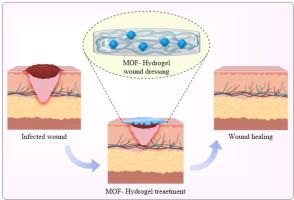当前位置:
X-MOL 学术
›
Coord. Chem. Rev.
›
论文详情
Our official English website, www.x-mol.net, welcomes your
feedback! (Note: you will need to create a separate account there.)
Metal-organic framework-hydrogel composites as emerging platforms for enhanced wound healing applications: Material design, therapeutic strategies, and future prospects
Coordination Chemistry Reviews ( IF 20.3 ) Pub Date : 2024-11-14 , DOI: 10.1016/j.ccr.2024.216330 Fereshte Hassanzadeh Afruzi, Majid Abdouss, Ehsan Nazarzadeh Zare, Erfan Rezvani Ghomi, Shima Mahmoudi, Rasoul Esmaeely Neisiany
Coordination Chemistry Reviews ( IF 20.3 ) Pub Date : 2024-11-14 , DOI: 10.1016/j.ccr.2024.216330 Fereshte Hassanzadeh Afruzi, Majid Abdouss, Ehsan Nazarzadeh Zare, Erfan Rezvani Ghomi, Shima Mahmoudi, Rasoul Esmaeely Neisiany

|
Wound healing remains a significant global healthcare challenge, particularly for chronic and complex wounds, imposing the development of advanced therapeutic materials with improved functionality and efficacy. The emergence of hybrid and composite materials offers promising solutions to the multifaceted challenges of wound healing, including infection control and tissue regeneration. Metal-organic frameworks (MOFs) have gained attention due to their high porosity, large surface areas, structural tunability, and potential to incorporate therapeutic agents, making them ideal candidates for wound healing applications. Additionally, hydrogels are recognized for their soft, porous, extracellular matrix-like structure, moisturizing properties, and biocompatibility, which make them valuable in wound care. The integration of MOFs with hydrogels creates synergistic hybrid systems that combine the exceptional cargo-loading capacity and controllable degradation of MOFs with the biocompatibility and moisture-retention properties of hydrogels. This results in enhanced wound healing potential compared to the individual components. This article overviews the wound healing process and current therapeutic challenges, surveys the biomedical applications of MOFs and hydrogels individually, and presents their preparation methods. A detailed analysis of MOF-hydrogel composites (MOF-HCs) is provided including their functionality, wound-healing mechanisms, closure capabilities, and biocompatibility. This article also offers critical insights, supported by a thorough review of current research. Finally, the existing challenges and proposed future directions are highlighted, offering valuable perspectives for researchers in the field.
中文翻译:

金属-有机框架-水凝胶复合材料作为增强伤口愈合应用的新兴平台:材料设计、治疗策略和未来展望
伤口愈合仍然是一项重大的全球医疗保健挑战,尤其是对于慢性和复杂伤口,这迫使开发具有改进功能和功效的先进治疗材料。混合和复合材料的出现为伤口愈合的多方面挑战提供了有前途的解决方案,包括感染控制和组织再生。金属有机框架 (MOF) 因其高孔隙率、大表面积、结构可调性以及掺入治疗剂的潜力而受到关注,使其成为伤口愈合应用的理想选择。此外,水凝胶因其柔软、多孔、细胞外基质样结构、保湿特性和生物相容性而受到认可,这使得它们在伤口护理中具有价值。MOF 与水凝胶的整合创造了协同混合系统,将 MOF 卓越的载货能力和可控降解与水凝胶的生物相容性和保湿特性相结合。与单个组件相比,这导致伤口愈合潜力增强。本文概述了伤口愈合过程和当前的治疗挑战,分别调查了 MOF 和水凝胶的生物医学应用,并介绍了它们的制备方法。提供了 MOF-水凝胶复合材料 (MOF-HCs) 的详细分析,包括它们的功能、伤口愈合机制、闭合能力和生物相容性。本文还提供了重要的见解,并得到了对当前研究的全面回顾的支持。最后,强调了存在的挑战和提出的未来方向,为该领域的研究人员提供了有价值的前景。
更新日期:2024-11-14
中文翻译:

金属-有机框架-水凝胶复合材料作为增强伤口愈合应用的新兴平台:材料设计、治疗策略和未来展望
伤口愈合仍然是一项重大的全球医疗保健挑战,尤其是对于慢性和复杂伤口,这迫使开发具有改进功能和功效的先进治疗材料。混合和复合材料的出现为伤口愈合的多方面挑战提供了有前途的解决方案,包括感染控制和组织再生。金属有机框架 (MOF) 因其高孔隙率、大表面积、结构可调性以及掺入治疗剂的潜力而受到关注,使其成为伤口愈合应用的理想选择。此外,水凝胶因其柔软、多孔、细胞外基质样结构、保湿特性和生物相容性而受到认可,这使得它们在伤口护理中具有价值。MOF 与水凝胶的整合创造了协同混合系统,将 MOF 卓越的载货能力和可控降解与水凝胶的生物相容性和保湿特性相结合。与单个组件相比,这导致伤口愈合潜力增强。本文概述了伤口愈合过程和当前的治疗挑战,分别调查了 MOF 和水凝胶的生物医学应用,并介绍了它们的制备方法。提供了 MOF-水凝胶复合材料 (MOF-HCs) 的详细分析,包括它们的功能、伤口愈合机制、闭合能力和生物相容性。本文还提供了重要的见解,并得到了对当前研究的全面回顾的支持。最后,强调了存在的挑战和提出的未来方向,为该领域的研究人员提供了有价值的前景。


















































 京公网安备 11010802027423号
京公网安备 11010802027423号